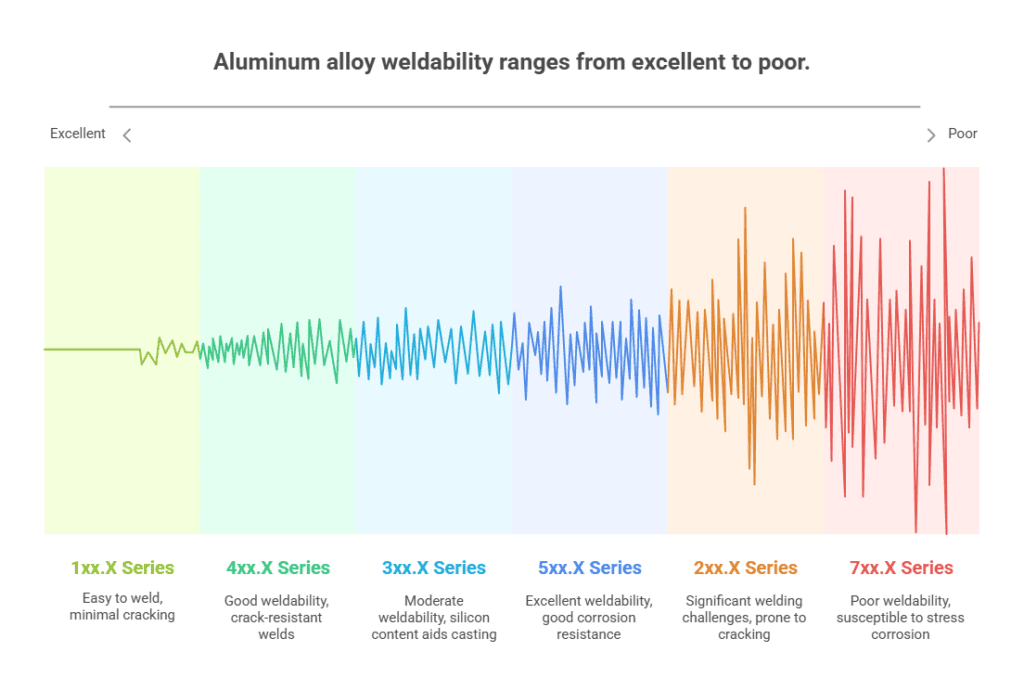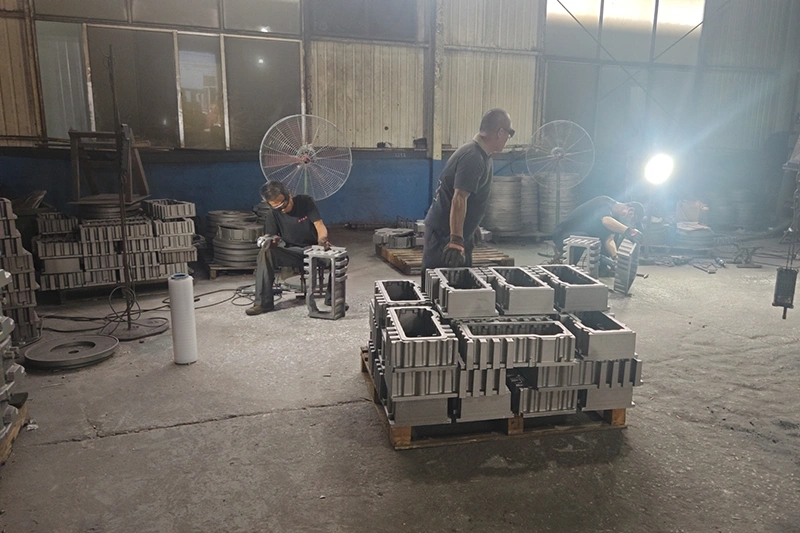Aluminum castings vary widely in their ability to be welded successfully. The alloy series, casting process, and part identification are important in determining whether you can weld a cast aluminum part and which filler metal to use.
This guide breaks down each aluminum casting series (1xx.x through 7xx.x) with specific welding recommendations, explains how to identify unknown castings through visual inspection, and details how different casting processes affect weldability.

Pure aluminum castings have excellent weldability. These alloys contain 99% or more aluminum with minimal alloying elements. The lack of additives makes them easy to weld without cracking issues.
For filler metal, use 1100 or 4043. The 1100 filler matches the base material composition, while 4043 adds silicon for better fluidity.
Aluminum-copper castings present significant welding challenges. The copper content ranges from 4% to 10%, making these alloys prone to hot cracking during welding. Many fabricators consider 2xx.x series castings non-weldable for critical applications.
If welding is absolutely necessary, use 4043 filler metal. Pre-heat the cast part to 300-400°F and maintain this temperature during welding. Post-weld heat treatment restores mechanical properties but requires precise temperature control.
These castings dominate the aluminum casting market, representing approximately 90% of all commercial aluminum castings. The silicon content (5-12%) provides excellent castability and moderate weldability. Common alloys include 356, 319, and A356.
Use 4043 or 5356 filler metals depending on the specific alloy. For 356 and A356 castings, 4043 works best due to its matching silicon content. Castings with higher magnesium content (over 0.5%) may benefit from 5356 filler for better color match after anodizing.
High-silicon castings offer good weldability when silicon content stays below 12%. These alloys flow well during casting and produce crack-resistant welds. The 413 and 443 alloys are common examples in this series.
Select 4043 or 4047 filler metals. The 4047 filler contains 12% silicon and works particularly well for high-silicon base materials. It produces smoother weld beads and reduces the risk of porosity.
Aluminum-magnesium castings exhibit excellent weldability and corrosion resistance. The magnesium content (4-10%) provides good strength without compromising weld quality. These alloys see frequent use in marine and chemical processing applications.
Choose 5356 or 5183 filler metals. The 5356 filler works for most applications, while 5183 provides higher strength for castings with magnesium content above 4.5%.
These high-strength castings have poor weldability. The zinc content (5-7%) combined with magnesium creates susceptibility to stress corrosion cracking. Welding often reduces mechanical properties by 50% or more in the heat-affected zone.
When welding is unavoidable, use 5356 filler metal. Minimize heat input and avoid welding in critical stress areas. Consider alternative joining methods like mechanical fasteners for structural applications.
Contact the original manufacturer if documentation is unavailable. Many foundries keep records of castings produced decades ago. The casting date code or foundry mark can help trace the alloy specification.
Wall Thickness
Measure the thinnest and thickest sections of the casting.

Ejector Pin Marks
Die castings show circular marks (0.125-0.500 inches diameter) where ejector pins pushed the part from the die. These marks appear on one side of the casting in a regular pattern.
Sand and investment castings lack these distinctive marks.
Given that 3xx.X series alloys constitute the vast majority of commercial castings, assuming the part belongs to this family and selecting a 4043 filler metal is a statistically probable starting point. This approach works for approximately 9 out of 10 unknown castings.
Perform a test weld on a non-critical area before committing to production welding. Watch for excessive cracking, porosity, or unusual discoloration that might indicate a different alloy series.
Sand castings generally offer the best weldability among all casting processes. The slower cooling rate produces larger grain structures with minimal residual stress. Gas porosity remains low because the sand mold allows gases to escape during solidification.
Welders can use standard parameters without special precautions. The coarse grain structure accommodates weld shrinkage stresses better than fine-grained materials. Surface preparation requires removing sand inclusions and oxide layers before welding.
Permanent mold castings fall between sand and die castings for weldability. The metal mold produces faster cooling than sand, creating finer grain structure and moderate residual stresses. These castings show good dimensional accuracy with minimal porosity.
Reduce welding heat input by 10-15% compared to sand castings. The finer grain structure increases hot cracking sensitivity slightly. Preheat to 200-250°F for sections over 0.500 inches thick.
High-pressure die castings present the greatest welding challenges. The rapid injection of molten metal traps gas and lubricants within the casting. This internal porosity expands during welding, creating bubbles and craters in the weld bead.
Many die castings are considered non-weldable for pressure-containing applications. When welding is necessary, use the lowest heat input possible. TIG welding with pure argon shielding gas minimizes porosity expansion. Expect some porosity in the weld regardless of technique.

